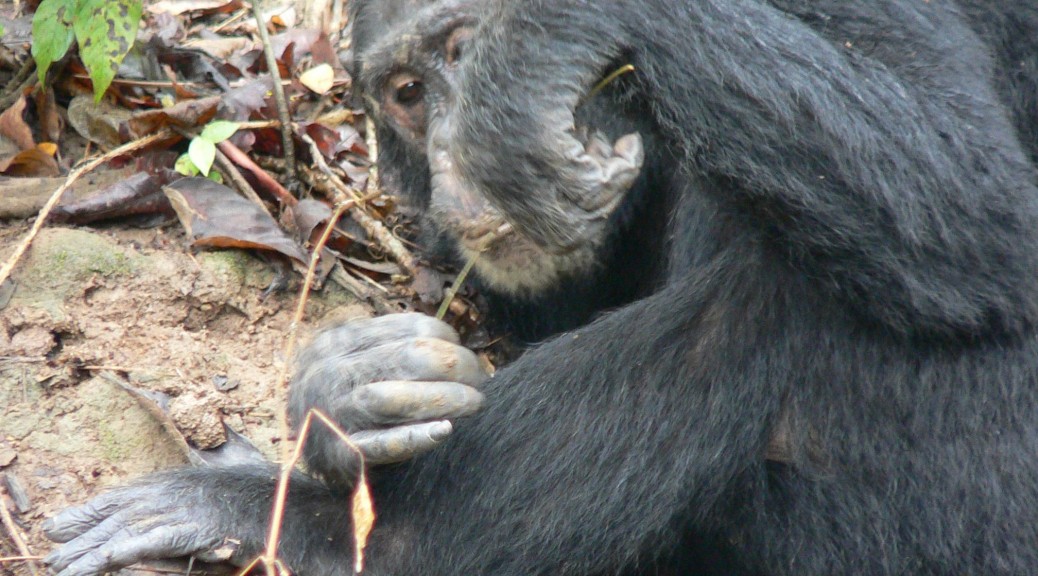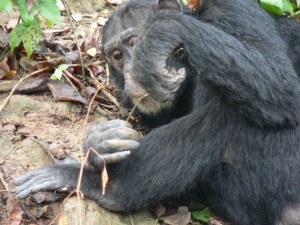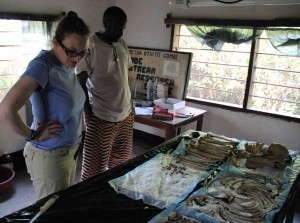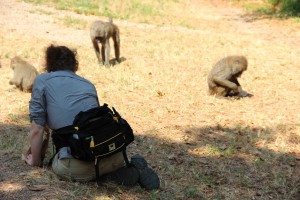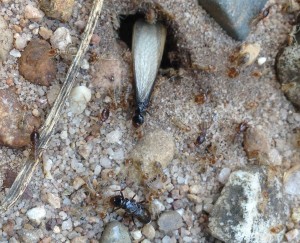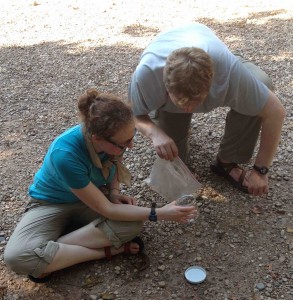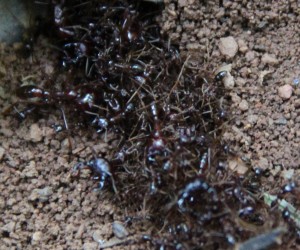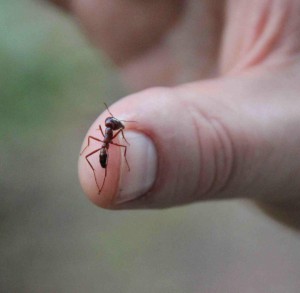28 July 2014
The latest Planet of the Apes movie raises interesting many interesting questions, such as: what would it take for other apes to replace humans as the planet’s ruling primates?
Spoiler Alert: if you haven’t seen the movie yet, you might not want to read any further until you have. I try to steer clear of plot details, but if you’re the kind of person who likes to know as little as possible about a movie before seeing it, consider yourself warned.
I grew up watching the original Planet of the Apes movies. I am sure seeing movies of a world ruled by apes fueled my interest in our hairy cousins. It was a rich time for anyone interested in apes. The first movie came out in 1968, the same year that the site where Jane Goodall studied chimpanzees, Gombe, was upgraded from a game reserve to a National Park. We watched films of Jane Goodall and the chimpanzees of Gombe in elementary school. New discoveries about the apes were reported regularly in the glossy pages of National Geographic. Studies of sign-language using apes like Washoe and Koko suggested apes were on the brink of human intelligence. Movies like King Kong and the Planet of the Apes franchise presented apes as both dangerous and fascinating, blurring the boundary between human and animal.
I had a special interest this latest Planet of the Apes movie as I contributed some recordings of chimpanzee vocalizations. As a result my name shows up on the big screen for a few seconds, after Ape Extras but before Editorial Assistant, New Orleans. The Chicago Sun-Times even noticed.
(The name Michael Wilson also shows up in the credits for the original movie, as writer of the screenplay — though that was of course somebody else!)
I thought they did a good job with ape vocalizations in the movie. One of my complaints in general about animals in movies is that they make much more noise than animals do in real life. Movie predators, whether lions or dinosaurs, always seem to roar right before attacking their prey – something real predators would never do, as they seek to catch their prey by surprise. Roars are for warning members of your own species to stay away (and/or for attracting mates), not for chasing away your prey!
Chimpanzees can be extremely noisy, but most of the time they are very quiet. So one of my recommendations to the sound editors was to avoid extraneous calls. I was very pleased to see that for many scenes, the apes were indeed fairly quiet.
And when the apes did vocalize, I enjoyed hearing real ape calls, and different calls for each species. I particularly liked one scene where the apes give a massive round of pant-grunts to Caesar. This is a call that chimpanzees use to show submission, and they used it in the right context for this film.
I liked that the apes mainly used sign language, and that when they did speak, they had rough, breathy voices, much like Viki the chimpanzee did when being trained to say words like “cup” and “up.”
In general, I thought the film did an excellent job building the characters and story. The main ape and human characters are complex, with understandable motives, and aren’t depicted as being either simply good or evil.
I think this might be the best movie yet in the franchise, and well worth seeing.
As an ape ecologist, though, I can’t help thinking about certain things.
For example, Muir Woods seems like a pretty rotten place for apes to live. It has trees, sure, but they are mainly redwoods and other conifers that produce no ape-friendly food. Apes are specialists in ripe fruit, which is in pretty short supply in a redwood forest. According to the Muir Woods website:
“Life in a redwood forest is determined by the low light conditions that restrict growth of plant species producing flowers, nuts, or berries. In addition, coast redwood trees contain an abundance of tannin (or tannic acid), a chemical compound that deters the presence of insects. Taken together, these conditions create an environment that is relatively low in the resources that typically form the base of a food web.”
So while it’s really cool to see apes swinging from the branches of redwoods, that forest is pretty grim habitat for apes. The gorillas might be able to subsist on herbs growing in the understory, but these are largely ferns and not very palatable. The chimps and orangutans would be pretty hungry there. They might use the forest as a temporary refuge, but would quickly move on to more suitable habitat, such as the overgrown gardens and city parks of post-apocalyptic suburbs.
If ordinary chimpanzees, gorillas and orangutans were released into the California wilderness, they would probably go their separate ways. The orangutans would forage alone. The male gorillas would compete over the female gorillas, until each silverback had a small group of females for himself. Each gorilla group would then forage separately. The chimps might start off as a single community but over time they would probably fission into several mutually hostile communities, each defending their own territory. It’s not clear why these different ape species stick together, or why they live in a village instead of sleeping up in the trees like real apes do. But of course these are retrovirus-mutated, hyper-intelligent talking apes, so they behave differently.
The film is surprisingly conservative in depicting ape romantic relationships, in that Caesar at least seems to be in a monogamous marriage with Cornelia. I suppose showing Caesar as a loyal family man makes him more appealing to viewers. However, a normal alpha male chimpanzee would try to monopolize matings with all the fertile females; and these females would try to mate with multiple males, even against the wishes of the alpha male. But perhaps the mutating retrovirus also makes apes monogamous.
But a big question relates to the film’s fundamental premise: what would it take to destroy human civilization, and clear the way for the world to be ruled by another kind of ape? (Or, in this case, a triumvirate of three different ape species.)
As Ruben Bolling points out,the Rise of the Planet Ape is a true story, and we are living it: we are the apes that have taken over the whole planet. But is human domination of the planet inevitable? How hard would humanity have to be hit to make way for other apes?
In this movie, humans are very nearly wiped out by a genetically engineered retrovirus, ALZ-113, that makes nonhuman apes super intelligent but kills humans. (This has interesting parallels with SIVcpz, a naturally occurring retrovirus, which was transmitted from chimpanzees to humans, probably by people hunting and butchering chimpanzees for food. When contracted by people, the virus is called HIV-1 and causes the disease AIDS, which has killed many millions of people around the world. SIVcpz doesn’t make apes super intelligent, of course, and we have learned that it is also fatal to chimpanzees (Keele et al., 2009)).
According to newscasts in the movie, almost everyone who contracts the virus dies; only 1 in 500 survive. Since the virus is highly contagious and transmitted by sneezing, this leads to a much more devastating result than even the AIDS pandemic.
There are about 7 billion people on the planet today. So if 1 in 500 people died, there would still be 14 million people on the planet. Such a rapid and catastrophic epidemic would have huge impacts on the survivors, though, as food distribution systems and everything else collapsed. Say only 1 in 10 of people who survived the virus would survive the aftermath of collapsing civilization. That would bring the total population of people on the planet down to 1.4 million (which is still four to five times the total number of chimpanzees living on the planet today). This is probably a low figure, given that many people on the planet are subsistence farmers and herders of livestock. Many people living in rural Africa, for example, would be able to survive the collapse of industrialized civilization, because they mainly live off the land without access to electricity, plumbing or fossil fuels.
In the San Francisco Bay Area, though, most people have no idea how to farm, herd livestock, or live off the land. Collapse would hurt people hard. So starting from a Bay Area population of about 7.44 million, if 1 in 500 die from disease, that leaves around 14,880 survivors. If 90% of those survivors died from starvation and post-apocalyptic fighting and such, then only around 1,488 people would be left in the Bay Area. That seems in line with the number of people crowded into the refuge of San Francisco (though as my wife noticed, the virus seems to have selectively killed all the Asians).
(Though why are they living in the middle of the city? I would think any survivors would mainly live on isolated rural farmsteads, where they can grow their own food, rather than crowding into the city center. How do these people eat? But it does look cool and dystopian to have everyone crowded together in the post-apocalypse city — maybe more so than setting it, say, on the outskirts of post-apocalypse Fresno.)
(Some other quibbles: Ten years post-apocalypse, I’m not sure anyone would still have usable manufactured clothing, eyeglasses or electronics anymore. Even in my own family, after a year living abroad, with easy access to clothing and other supplies, the clothes we brought with us are ragged, the kids need new eyeglasses, and my son and I both need new shoes. Life post-apocalypse would certainly be much harder on such supplies. Moreover, there would certainly be no birth control or antibiotics. Sexually active women would be pregnant or nursing — which would have huge impacts on society. Weirdly, almost no young human children, or women with nursing babies, were shown in this film.)
ANYWAY…
Based on the number of apes living in Muir Woods, they must have been reproducing at a really high rate compared to normal apes. This wiki states that there are 2,000 apes living in the ape village. Now that’s a lot of apes. Currently there are only about 2,000 captive chimpanzees in the United States. The starting population in Muir Woods must have been a lot less than that, since they started with apes escaping from just two captive colonies, and it would be hard for apes from other parts of the country to find out about the Muir Woods population, much less travel there.
Is it realistic to have 2,000 apes in ape village just 10 years after the ape revolution?
One key to the success of humans is demography. We can reproduce much faster than other apes. For example, suppose by coincidence that both the surviving human population in San Francisco, and the chimpanzee population in Muir Woods, started out at about 1,000 individuals. (Gorillas reproduce more quickly than chimpanzees, and orangutans reproduce more slowly, but since in the movie most of the apes are chimps, I’ll focus on them.) In a best case scenario, chimpanzee populations could potentially grow at about 2% per year. (Most wild chimpanzee populations “grow” at about 0% per year, though, because mortality is high and food supplies are limited — which in turn limits fertility and growth.)
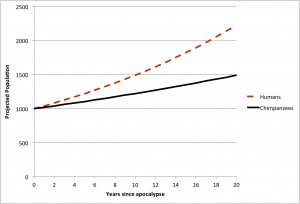
So starting out with 1,000 chimps, in ten years there would be only about 1,221 chimps (if they somehow found food and didn’t suffer high mortality from predation, warfare etc.). Human hunter-gatherers, though, can grow at much faster rates, such as around 4%, even without medical care and with all of the hardships that hunter-gatherers face. At this rate, starting with 1,000 humans, we’d have around 1,492 people by the end of ten years — so about 270 more humans than chimps. And realistically, survivors in California would be farmers, not hunter-gatherers, with potentially even faster population growth. So if Ape Village apes are reproducing like normal chimpanzees, and if the starting population was in the hundreds, a population of 2,000 ten years later is not realistic.
Why can human populations grow so much faster than chimpanzees?
In some ways it is surprising that this can even be possible. After all, humans take longer to reach maturity than chimpanzees. Female chimpanzees have their first birth around age 14 (males reach full size around age 16, but for population growth, it’s females that matter more). Humans hunter-gatherers take longer to mature, with an average age of first birth at 18-20 (Hill & Kaplan 1999). Moreover, even though humans live longer than chimpanzees, human females stop reproducing in their forties — so their reproductive careers are, on average, shorter than those of chimpanzees.
However, once humans do grow up, they can reproduce quickly. Chimpanzees have an average interval of around 5 years (Jones et al., 2010), whereas hunter-gatherers have an interbirth interval of only 4 years (Hill & Kaplan 1999).
How can women reproduce more quickly than chimpanzees? A big part of the answer must be cooking. Thanks to fire, humans can extract more energy from the environment, by increasing the energy available from food, and by making otherwise unpalatable foods safe to eat (Wrangham et al., 1999). Cooking likely helps children grow faster, by providing soft, energy rich foods from a young age, whereas chimpanzee children continue drinking their mother’s milk for longer, as they gradually add tough, hard adult foods to their diet. This surely has a big impact on human fertility and growth rates.
In the movie, the apes in Ape Village had fires in each house, so maybe they were cooking? That would certainly help them reproduce more quickly.
Another reason human populations can grow so much faster than chimpanzee populations is that humans have much lower mortality than chimpanzees, even in hunter-gatherer populations without access to medicine. Hunter-gatherers regularly live into their 50s, whereas the median age of survival for wild chimpanzees is about 30, and few live into their 40s. What accounts for this difference?
I suspect cooking is probably important for reducing mortality as well. Cooking and other food extraction and preparation technology likely help people obtain food even in difficult times of the year, whereas chimpanzees in seasonal environments may become weak and more likely to die from diseases. Cooking also must help people live longer by providing soft foods that they can continue to eat into old ages, as their teeth wear down.
So super-intelligent mutant apes potentially *could* take over the world, but only if most of the humans are killed off, and apes learn how to cook.
Works cited:
Jones, J. H., M. L. Wilson, C. M. Murray and A. E. Pusey (2010). “Phenotypic quality influences fertility in Gombe chimpanzees.” Journal of Animal Ecology 79(6): 1262-1269. get pdf
Keele, B. F., J. H. Jones, K. A. Terio, J. D. Estes, R. S. Rudicell, M. L. Wilson, Y. Li, G. H. Learn, T. M. Beasley, J. Schumacher-Stankey, E. E. Wroblewski, A. Mosser, J. Raphael, S. Kamenya, E. V. Lonsdorf, D. A. Travis, T. Mlengeya, M. J. Kinsel, J. G. Else, G. Silvestri, J. Goodall, P. M. Sharp, G. M. Shaw, A. Pusey, E. and B. H. Hahn (2009). “Increased mortality and AIDS-like immunopathology in wild chimpanzees infected with SIVcpz.” Nature 460: 515-519. get pdf
Hill, K. and H. Kaplan (1999). “Life history traits in humans: Theory and empirical studies.” Annual Review of Anthropology 28: 397-430. get pdf
Wrangham, R. W., J. H. Jones, G. Laden, D. Pilbeam and N. Conklin-Brittain (1999). “The raw and the stolen: cooking and the ecology of human origins.” Current Anthropology 40(5): 567-594. get pdf

